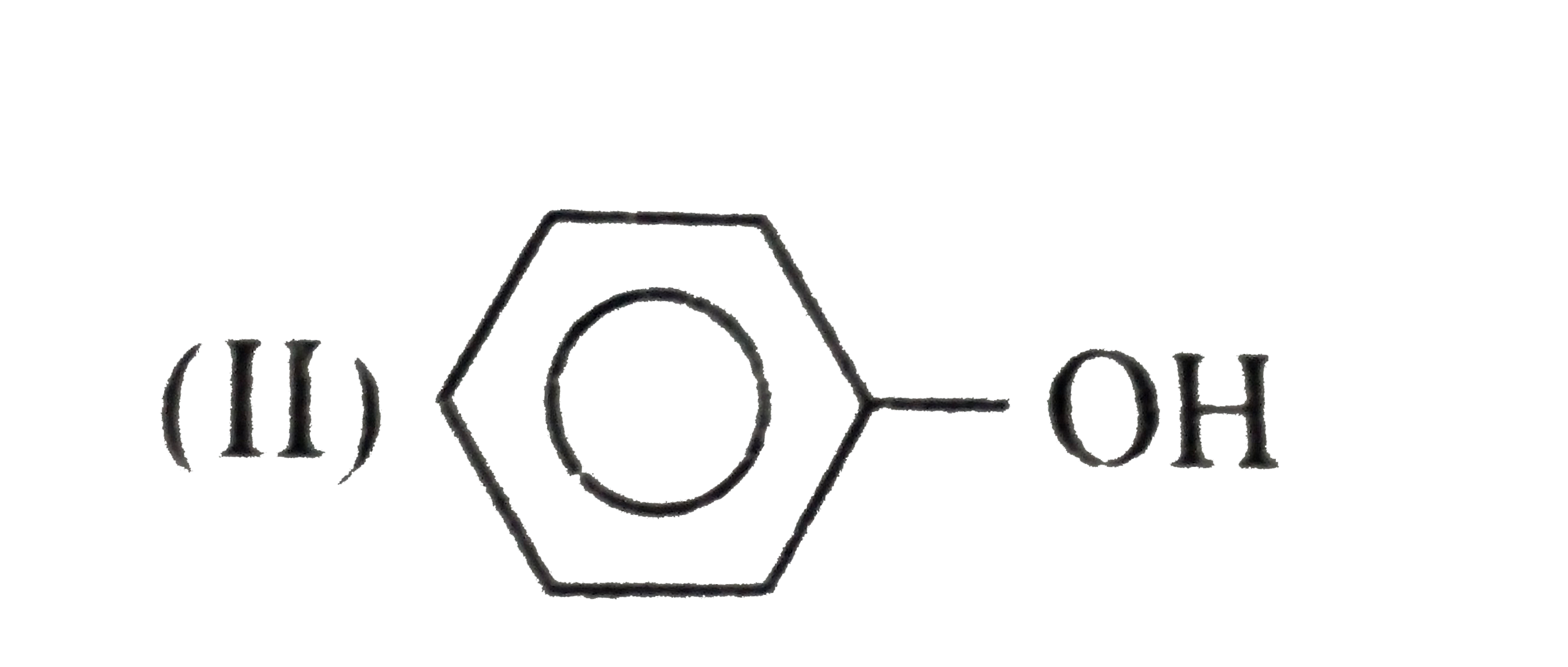Give the decreasing order of hydrate formation of the following.
I. HCHO II. PhCHO
III. Chloral IV. Acetone
(III)>(I)>(II)>(IV)
(IV)>(II)>(I)>(III)
(I)>(III)>(II)>(IV)
(IV)>(II)>(III)>(I)
The correct Answer is:A
To determine the decreasing order of hydrate formation for the compounds given (I. HCHO, II. PhCHO, III. Chloral, IV. Acetone), we need to analyze the nucleophilic addition reactions of these carbonyl compounds. The formation of hydrates occurs when a nucleophile attacks the electrophilic carbon atom of the carbonyl group. The extent of this reaction depends on the positive charge on the carbonyl carbon, which is influenced by the substituents attached to it.
1. Identify the Compounds:
- HCHO (Formaldehyde)
- PhCHO (Benzaldehyde)
- Chloral (CCl₃CHO)
- Acetone (CH₃COCH₃)
2. Understand Nucleophilic Addition:
- Nucleophilic addition occurs at the carbonyl carbon, which is electrophilic due to the partial positive charge created by the electronegativity of the oxygen atom.
3. Evaluate Electron-Withdrawing and Electron-Donating Effects:
- Formaldehyde (HCHO): No significant electron-withdrawing or donating groups. It has a moderate positive charge on the carbonyl carbon.
- Benzaldehyde (PhCHO): The phenyl group (Ph) has a -I (inductive) effect, which withdraws electron density from the carbonyl carbon, increasing its positive charge slightly compared to formaldehyde.
- Chloral (CCl₃CHO): The three chlorine atoms are strong electron-withdrawing groups. They significantly increase the positive charge on the carbonyl carbon, making it very electrophilic and enhancing nucleophilic addition.
- Acetone (CH₃COCH₃): The two methyl groups are electron-donating (due to +I effect), which reduces the positive charge on the carbonyl carbon, making it less electrophilic and less favorable for nucleophilic addition.
4. Rank the Compounds Based on Electrophilicity:
- Chloral: Highest electrophilicity due to strong electron-withdrawing effect from three chlorine atoms.
- Formaldehyde: Moderate electrophilicity; better than benzaldehyde due to less steric hindrance.
- Benzaldehyde: Slightly less electrophilic than formaldehyde due to the presence of the phenyl group.
- Acetone: Lowest electrophilicity due to electron-donating methyl groups.
5. Final Order of Hydrate Formation:
- Chloral > Formaldehyde > Benzaldehyde > Acetone
Conclusion:
The decreasing order of hydrate formation is:
III. Chloral > I. HCHO (Formaldehyde) > II. PhCHO (Benzaldehyde) > IV. Acetone
- HCHO (Formaldehyde)
- PhCHO (Benzaldehyde)
- Chloral (CCl₃CHO)
- Acetone (CH₃COCH₃)
- Nucleophilic addition occurs at the carbonyl carbon, which is electrophilic due to the partial positive charge created by the electronegativity of the oxygen atom.
- Formaldehyde (HCHO): No significant electron-withdrawing or donating groups. It has a moderate positive charge on the carbonyl carbon.
- Benzaldehyde (PhCHO): The phenyl group (Ph) has a -I (inductive) effect, which withdraws electron density from the carbonyl carbon, increasing its positive charge slightly compared to formaldehyde.
- Chloral (CCl₃CHO): The three chlorine atoms are strong electron-withdrawing groups. They significantly increase the positive charge on the carbonyl carbon, making it very electrophilic and enhancing nucleophilic addition.
- Acetone (CH₃COCH₃): The two methyl groups are electron-donating (due to +I effect), which reduces the positive charge on the carbonyl carbon, making it less electrophilic and less favorable for nucleophilic addition.
- Chloral: Highest electrophilicity due to strong electron-withdrawing effect from three chlorine atoms.
- Formaldehyde: Moderate electrophilicity; better than benzaldehyde due to less steric hindrance.
- Benzaldehyde: Slightly less electrophilic than formaldehyde due to the presence of the phenyl group.
- Acetone: Lowest electrophilicity due to electron-donating methyl groups.
- Chloral > Formaldehyde > Benzaldehyde > Acetone
The decreasing order of hydrate formation is:
III. Chloral > I. HCHO (Formaldehyde) > II. PhCHO (Benzaldehyde) > IV. Acetone
Topper's Solved these Questions
- ALIPHATIC AND AROMATIC ALDEHYDES AND KETONESBOOK - CENGAGE CHEMISTRY ENGLISHCHAPTER - ALIPHATIC AND AROMATIC ALDEHYDES AND KETONESEXERCISE - Exercises Assertion-Reasoning
6 Videos
- ALIPHATIC AND AROMATIC ALDEHYDES AND KETONESBOOK - CENGAGE CHEMISTRY ENGLISHCHAPTER - ALIPHATIC AND AROMATIC ALDEHYDES AND KETONESEXERCISE - Archives Objective
10 Videos
- ALIPHATIC AND AROMATIC ALDEHYDES AND KETONESBOOK - CENGAGE CHEMISTRY ENGLISHCHAPTER - ALIPHATIC AND AROMATIC ALDEHYDES AND KETONESEXERCISE - Exercises Multiple Correct
33 Videos
- ALCOHOL,PHENOL AND ETHERSBOOK - CENGAGE CHEMISTRY ENGLISHCHAPTER - ALCOHOL,PHENOL AND ETHERSEXERCISE - Archives Analytical And Descriptive
15 Videos
- APPENDIX INORGANIC VOLUME 2BOOK - CENGAGE CHEMISTRY ENGLISHCHAPTER - APPENDIX INORGANIC VOLUME 2EXERCISE - Short Answer Type
179 Videos
Similar Questions
Give the decreasing order of the octane rating of the following:
i.
View SolutionDecreasing order of hydration energy of the following is
View SolutionThe decreasing order of acidic character of the following is:
(I) (II)
(II) 
(III) (IV)
(IV) 
View SolutionGive the increasing order of melting points of the following compounds:
a. I. NaF , II. NaCl , III. NaBr, IV. NaI
b. I. CaI2 , II. CaBr2 , III. CaCl2 , IV. CaF2 , V. BeCl2
d. I. NaCl , II. MgCl2 , III. AlCl3
e. I. CCl4 , II. BCl3 , III. BeCl2 , IV. LiCl
View SolutionThe decreasing order of acidic character of the following is :
(I) CH3SH
(II) CH3OH
(III) H2O
(IV) EtOH.
View SolutionThe decreasing order of aromaticity fo the following is
I. Benzene, II. Napthalene, III. Anthrance
View SolutionGive the decreasing order of covalent character of the following compounds.
a. I. GeCl2 II. GeCl4 III. SnCl2 IV. SnCl4
V. PbCl2 VI. PbCl4
b. I. CH4 II. NH3 III. H2O IV. HF
c. I. HF II. HCl III. HBr IV. HI
d. I. AgI II. NaI III. CuI IV. NaCl
View SolutionThe decreasing order of -I effect of the following is
I. −⊕NH3.
II. −NO2
III. −CN
IV. −COOH
View SolutionThe decreasing order of prority for the following functional group is
I. C≡N II. −CONH2
III. IVgt −CHO
IVgt −CHO
View SolutionGive the decreasing order of the relative reactivity towards SE reaction of the following compounds.
a. I. Benzene, II. Phenol, III. Aniline, IV. Chlorobenzene
View Solution
